|

Scotland
County is located in Southeastern North Carolina adjacent to the South
Carolina line. The County, which is 18 miles east to west and 25
miles north to south, is located halfway between Charlotte, the
state's largest city, and Wilmington, the state's largest port.
The
population of Scotland County is more than 35,000 with nearly 17,000
living in
Laurinburg, the County seat. Gibson, Wagram, East Laurinburg, the
unincorporated community of Laurel Hill and part of the town of Maxton
make up the various communities in the County.
by Betty P. Myers,
1975; Revised 1977, 1994
Although Scotland County is relatively young
among North Carolina counties, having been formed in 1899, it has a rich
and interesting history. As is true with all history, the history of
this county is so entwined with our geography, sociology, economics, and
government that separating them is neither feasible nor desirable.
Because of this, and because of the variations in the pattern of
settlement in the various parts of the county, no attempt has been made
to make this the typical chronological history. Instead, a brief
background summary will be presented. Then an imaginary tour of the
county will follow, with items of historical interest inserted
geographically rather than chronologically.
The earliest settlers in what is now
Scotland County were composed largely of Highland Scots. It is fairly
well established by several writers of Scottish history that there were
Highlanders living in this area as early as 1729, when North Carolina
became a royal colony. However, much of the Scot settlement came in the
next quarter century. It was during this period that many Scots pushed
up the Cape Fear River into the area surrounding their Cross Creek
settlement, later Campbellton, now Fayetteville, and consequently, into
the area that is now Scotland County.
Through the ensuing years, other groups and
individuals have come to the county, bringing their own heritage to
mingle with that of the Scots, Scotch-Irish, English, Welsh, and
African. Some of our present-day citizens can even link their heritage
to that of the first Americans -- the Native Americans. So although the
name of the county is Scotland and the Scottish influence is quite
strong, the Scots have no monopoly on the county or its history.
The political beginning for Scotland County
came when the legislature of North Carolina, on February 20, 1899,
created the new county. The county was formed entirely from Richmond
County. The entire area had been a part of Anson County and, before
that, a part of Bladen.
The main reason given for the movement to
break away from Richmond County was that the county seat, Rockingham,
being some twenty to thirty miles away, was too far from the eastern
part of the county. Any business in the county seat required an all-day
trip and sometimes an overnight stay on the part of many citizens.
However, there seem to have been other factors at work, including a
strong red shirt movement and much dissatisfaction with the county
government at Rockingham. There were charges and counter-charges and
strong feeling displayed by both proponents and opponents of the new
county. A petition opposing the formation of the new county was
circulated in the legislature of 1895 by Richmond County opponents of
the separation, and in the petition attention was called to the small
number of Populists and Republicans who voted in Laurinburg. The
accusation was that the number was so small because of intimidation in
the heavily Democratic town. One sentence read: Laurinburg, in politics,
ought to be called Rottenburg.
Mr. Maxey John wrote the act which created
the county. He had written similar acts twice before. In 1893, the act
failed to pass the General Assembly, and in 1895, the act passed, but
with a provision for an election in all Richmond County to approve or
disapprove the new county. The election failed to approve the new
county, and no serious attempt was made in the 1897 session of the
General Assembly, which was Republican-Fusionist controlled. However, in
1899, another attempt was made. The act was introduced in the General
Assembly by Mr. Hector McLean, who is sometimes called the Father of
Scotland County.
In the act establishing the county, the
legislature designated Laurinburg as the county seat and required that
the county commissioners select a site for a jail within a mile of the
center of town. The county began to function in December 1900, and the
wills and deeds books begin in that month.
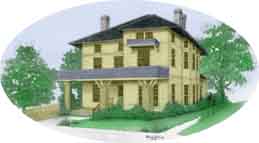 With this brief
background, let us begin our historical tour of the county in
Laurinburg, the county seat and the largest town. Although not
incorporated until 1877, Laurinburg is said to have had its beginning as
far back as 1785 when the first families settled on the present town
site. The name of the town was first written with an h -- Laurinburgh --
and was pronounced Laur-in-boro by some. The post office was first
called Laurinburgh, but later the h was dropped. The Laurin, of course,
came from the prominent McLaurin family. As late as 1840, there were
only three dwellings, a store, a saloon, and a few shacks in the town. A
private school was established in 1852 and the town seemed to grow
rapidly after that. As a matter of fact, the school was named
Laurinburgh High School, and it was from the school that the town took
its name. For some reason, the act incorporating Laurinburg used still
another spelling, Laurenburg. With this brief
background, let us begin our historical tour of the county in
Laurinburg, the county seat and the largest town. Although not
incorporated until 1877, Laurinburg is said to have had its beginning as
far back as 1785 when the first families settled on the present town
site. The name of the town was first written with an h -- Laurinburgh --
and was pronounced Laur-in-boro by some. The post office was first
called Laurinburgh, but later the h was dropped. The Laurin, of course,
came from the prominent McLaurin family. As late as 1840, there were
only three dwellings, a store, a saloon, and a few shacks in the town. A
private school was established in 1852 and the town seemed to grow
rapidly after that. As a matter of fact, the school was named
Laurinburgh High School, and it was from the school that the town took
its name. For some reason, the act incorporating Laurinburg used still
another spelling, Laurenburg.
Mr.
Washington Gill was the mayor of the new town. His home has been
preserved and restored. It was also the home of Edwin Gill, long-time
Treasurer of North Carolina.
The Laurinburgh High School stood along what
is now Caledonia Road, north of the Church Street intersection. Some of
the older houses along this road were made from parts of the school
buildings after they were no longer in use. One of these houses was the
boyhood home of Terry Sanford, who served as both Governor of North
Carolina and as United States Senator. Of course, this was many years
after the days of the Laurinburgh High School. Incidentally, the home in
which Mr. Sanford was born has been torn down. It stood on West Church
Street.
Laurinburg is said to have had its beginning
with the store and blacksmith shop which were near where our older water
tank now stands. This is very near the site of the high school mentioned
earlier.
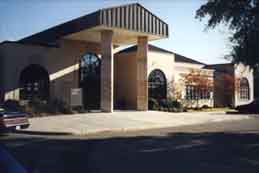 Another point of
interest in Laurinburg is the county’s new courthouse, built in 1964.
The county’s first courthouse was built in 1901, facing Main Street
where the A. B. Gibson Education Center now stands. Court was first held
in a rented building, and Judge Walter Neal, whose picture now hangs in
the Courtroom, held the first term of criminal court in the county the
week of November 18, 1901. Another point of
interest in Laurinburg is the county’s new courthouse, built in 1964.
The county’s first courthouse was built in 1901, facing Main Street
where the A. B. Gibson Education Center now stands. Court was first held
in a rented building, and Judge Walter Neal, whose picture now hangs in
the Courtroom, held the first term of criminal court in the county the
week of November 18, 1901.
On the
grounds of the new courthouse are two monuments of historical interest
which were moved from the old courthouse grounds. The Confederate
Monument is typical of many erected in the South in the years following
the Civil War. Public subscriptions were taken for it, and it was
originally placed in the center of the street at the intersection of
Church and Main Streets. As automobiles became more common, it proved to
be quite a traffic hazard and was moved to the courthouse grounds. The
Quakenbush Monument honors William Graham Quakenbush, who was principal
of Laurinburgh High School from 1879 to 1900. In fact, the school was
locally known as The Quakenbush School. Mr. Quakenbush was not only a
beloved educator, but he was also one of the leaders in the movement to
form Scotland County. North Carolina’s Education Governor, Charles B.
Aycock, spoke at the dedication of the monument. Recently, a monument
has been erected to honor local veterans of all wars.
Laurinburg’s Main Street is a point of historical interest in itself. It
is difficult to look down Main Street now and visualize the scene
described by residents in the late 1880s and early 1890s. There were
about 15 grocer or general stores and at least 13 of them sold whiskey.
Some of the ladies of the town hesitated to venture downtown alone
because of the boisterous behavior along the street. Mrs. Nettie
McCormick Henley described the situation well in her book, THE HOME
PLACE: A good many decent people lived in Laurinburg, but
women-folk generally thought of Main Street about the same way as the
movies show Western frontier towns. The young sports would brag, ‘There
are thirteen barrooms, and I had a drink in every one of them last
Saturday.’
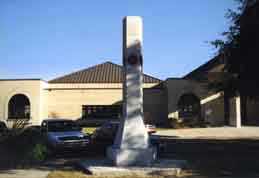 The stores along
the main street were operated by some of the town’s most prominent
citizens. Mr. John F. McNair started his business at Springfield and
Laurel Hill, and later moved it to Laurinburg’s Main Street in 1872. Mr.
McNair was a prominent businessman with far-reaching interests in land,
textiles, banking, and other enterprises. Mr. Walter Evans, a black man,
was another important Main Street merchant. He operated a clothing store
which specialized in good quality shoes. Mr. Evans was also a highly
respected businessman with holdings in land and other property. The
Everett Brothers and Gill Store was one of the most prosperous on Main
Street during the latter part of the 1800s and the first part of the
1900s. Everington’s Drug Store is also one of the older Main Street
businesses, started in 1882. Laurinburg’s Main Street even boasted an
opera house. The upstairs of the building at the corner of Main and
Roper Streets was used for traveling shows and for community events, and
was known as The Opera House. The stores along
the main street were operated by some of the town’s most prominent
citizens. Mr. John F. McNair started his business at Springfield and
Laurel Hill, and later moved it to Laurinburg’s Main Street in 1872. Mr.
McNair was a prominent businessman with far-reaching interests in land,
textiles, banking, and other enterprises. Mr. Walter Evans, a black man,
was another important Main Street merchant. He operated a clothing store
which specialized in good quality shoes. Mr. Evans was also a highly
respected businessman with holdings in land and other property. The
Everett Brothers and Gill Store was one of the most prosperous on Main
Street during the latter part of the 1800s and the first part of the
1900s. Everington’s Drug Store is also one of the older Main Street
businesses, started in 1882. Laurinburg’s Main Street even boasted an
opera house. The upstairs of the building at the corner of Main and
Roper Streets was used for traveling shows and for community events, and
was known as The Opera House.
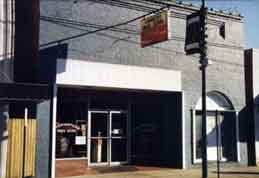 In the early
days, Main Street was dirt. It was paved in 1914. Main Street has been
the scene of many interesting parades, including a 1910 Fourth of July
parade. Many ordinances, such as this one, had to do with Main Street
and the other streets of the town: No horse or mule driver shall
turn his stock loose on the public street on Sunday between the hours of
8 a.m. and 2 p.m. In the early
days, Main Street was dirt. It was paved in 1914. Main Street has been
the scene of many interesting parades, including a 1910 Fourth of July
parade. Many ordinances, such as this one, had to do with Main Street
and the other streets of the town: No horse or mule driver shall
turn his stock loose on the public street on Sunday between the hours of
8 a.m. and 2 p.m.
In 1883,
the town’s charter was amended to include these among other provisions:
That the commissioners shall have power to prohibit by penalties the
riding or driving of horses or other animals in a careless or dangerous
manner, or at a greater speed than five miles per hour...
That the commissioners shall have power to declare it unlawful for any
horses, mules, cattle, hogs, sheep, goats, and dogs to run at large.
 The railroad has
always played an important part in the history of Laurinburg and the
county. In 1853, it was announced that the Wilmington, Charlotte and
Rutherfordton Railroad would come through, and the first trains ran in
1861, just in time to take a group of young men to fight in the Civil
War. During the war, the railroad moved its shops from Wilmington to
Laurinburg. The Northern fleet was concentrating a good deal of its
effort on Fort Fisher and the management felt that the shops would be
safer inland. Railroad officials first located the shops here with the
idea that they would be here for just a short time. However, they later
purchased additional land and the shops did stay until 1894. Many people
in the town lived in fear that when the shops left, the entire economy
of the area would collapse. Mr. Maxey John describes the feelings in his
history: The railroad has
always played an important part in the history of Laurinburg and the
county. In 1853, it was announced that the Wilmington, Charlotte and
Rutherfordton Railroad would come through, and the first trains ran in
1861, just in time to take a group of young men to fight in the Civil
War. During the war, the railroad moved its shops from Wilmington to
Laurinburg. The Northern fleet was concentrating a good deal of its
effort on Fort Fisher and the management felt that the shops would be
safer inland. Railroad officials first located the shops here with the
idea that they would be here for just a short time. However, they later
purchased additional land and the shops did stay until 1894. Many people
in the town lived in fear that when the shops left, the entire economy
of the area would collapse. Mr. Maxey John describes the feelings in his
history:
During
all these years the fear of disaster, should the shops move, was so
apparent that even those who were able to build largely and permanently
refused to do so, or as one of our citizens put it when his contractor
told him he was planning a home he did not want, the owner said: ‘Build
it so that if the shops leave and my business should be so crippled that
I shall have to go, too, that I will lose as little as possible in
selling out.’
Fortunately, soon after the shops left, the textile industry started to
move into the town. The railroad shops were instrumental in bringing
prosperity and economic activity to help Laurinburg get started. The
railroad continued to be an important part of the community. In the
first half of the century, hundreds of car loads of cantaloupes and
watermelons were shipped by rail from Laurinburg and the surrounding
towns. In fact, Laurinburg called itself The Capital of the Cantaloupe
World.
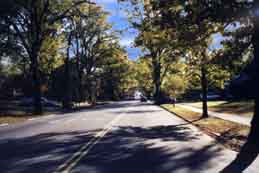 Another title
Laurinburg has given itself is The City of Beautiful Trees, and efforts
have been made from the town’s beginning to preserve our distinctive
trees. An early ordinance read: No person shall willfully,
carelessly, or negligently damage or destroy any of the shade trees. Another title
Laurinburg has given itself is The City of Beautiful Trees, and efforts
have been made from the town’s beginning to preserve our distinctive
trees. An early ordinance read: No person shall willfully,
carelessly, or negligently damage or destroy any of the shade trees.
Laurinburg received a good deal of national attention some years ago
with the story of Cancetto Farmica, known locally as Spaghetti. Farmica,
a carnival worker, was killed in 1911. The family never came to claim
the body, and it was held by a local funeral home until it was buried in
1972. During the years, the body became a kind of tourist attraction.
To the
east of Laurinburg proper is East Laurinburg. It was to East Laurinburg
that the textile industry came. It was in the last days of the 19th
century that the Waverly Mills operation began with the building of its
first plant, Scotland Mill. The town of East Laurinburg is composed
almost entirely of the villages which were built around the textile
plants. East Laurinburg is an incorporated town, legally separate from
Laurinburg.
The
oldest church in Laurinburg is the Laurinburg Presbyterian on West
Church Street, an off-shoot of the Old Laurel Hill Presbyterian Church.
This church was organized in 1859 and constructed a building in 1866 on
the site of the present-day church. Many of the early settlers were
Scots and Presbyterian, and there has always been a strong Presbyterian
influence in the community.
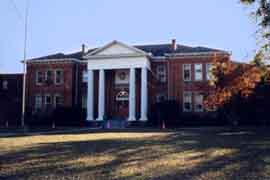 Laurinburg’s
oldest public school is Central School (now closed). Built in 1909, it
served as the only school for some years, containing both elementary and
high school classes. Laurinburg’s
oldest public school is Central School (now closed). Built in 1909, it
served as the only school for some years, containing both elementary and
high school classes.
The
Laurinburg High School, a part of the public school system, was built on
East Church Street in 1924 and was used as a high school until the
building of Scotland High School. It was then used as a junior high
school until it burned in 1973.
In the
northern part of town are two other schools of much historic interest.
Laurinburg Institute is the county’s oldest private school. This school,
in its present location on McGirt’s Bridge Road and in its former
location in the Newtown section, has served several generations of black
students. It was founded in 1904 by Mr. E. M. McDuffie and is still
operated by the McDuffie family. For many years this was the only school
in town for black students, and at one time it operated as both a public
and a private school. One interesting feature of the Institute in
earlier days was the hospital. operated as a part of the school by Dr.
N. E. Jackson. The school now operates as a preparatory school and has a
long list of well-known graduates.
I. Ellis
Johnson School was the black high school until the building of Scotland
High School and the simultaneous integration and consolidation of all
county schools. The school was named for Mr. I. Ellis Johnson, a
long-time educational leader in the county and the first principal of
the school.
It is
fitting that we started and ended our imaginary tour of Laurinburg with
schools. The town grew up around and school and actually derived its
name from that school. It is also fitting that we begin our imaginary
tour of the rest of the county with a school. Let us move to the south
of Laurinburg and begin our tour of the county at St. Andrews
Presbyterian College.
There is
a legend to the effect that when the first Scottish settlers started
moving up the Cape Fear River and inland from Wilmington, someone posted
a sign which read, The best land lies 100 miles west of here. The story
goes on that those who could read came to what is now Scotland County.
This interest in things educational was rewarded in 1956 with the
announcement that a new Presbyterian college was coming to the land of
the Scots. Since its opening in 1961, St. Andrews has played a vital
role in the life of the county.
As the
Scots were settling in the upper part of the county, several families of
Welsh descent moved up from what is now Marlboro County, South Carolina,
to the southern tip of what is now Scotland County. Of course, some of
the Scots in the area also came from South Carolina, coming by way of
the Pee Dee River. This was largely a farming community, with a few
small stores scattered about. As the railroad came through two small
villages sprang up. One of these was Hasty, now a small, almost deserted
village south of St. Andrews. James A. Hasty, for whom the community is
named, owned the property on which the railroad station was located. A
telephone switchboard was installed in the Hasty depot in 1902, but was
transferred to Laurinburg some four years later. There was a Hasty post
office from 1886 until 1930, and a public school was established in
1897. An interdenominational church was founded in 1886.
The
second community to spring up along the railroad track in the lower part
of the county was Johns Station, often called Johns. Mr. J. T. John
started operating a general store by the railroad in 1886 and a post
office was established there the same year. A school was already
operating in the community.
Nearby
Caledonia Methodist Church was organized in 1835 and is the mother
church for most of the county’s Methodist churches.
A school
of some historic interest in this part of the county was Oak Grove. It
served as the Indian school until the integration of all county
schools.
Another
landmark in the lower part of the county is Stewartsville Cemetery,
founded in 1785. This is one historic place in the county which has
significance for all three races. The cemetery, from its earliest days,
has served as burial ground for black, white, and Indian. The first
burial in the cemetery is believed to have been that of a Revolutionary
War soldier who died at Stewartsville, then a thriving community, on his
way home from the war. Many of the earliest graves have very simple
markers with no names or dates. Two of the graves are those of
Presbyterian ministers whose names today recall colorful stories.
One of
these was the Rev. Archibald McQueen. His tombstone is inscribed: An
able lawyer, a skillful physician, and a consecrated preacher. He
was born about 1795 and died in 1854. He served Old Laurel Hill and
Smyrna Churches. He was forced to resign as a result of his marriage to
his dead wife’s sister. In those days, this action was a violation of
the Presbyterian Confession of Faith.
Another
interesting person buried at Stewartsville is the Reverent Colin
Lindsay. He preached at Red Bluff Church. He, too, was suspended from
the Presbytery for too free use of ardent spirits and violent temper,
but this is not the most interesting story about him. He is the man born
after his mother was buried. He was born in Scotland in 1744 and
migrated to America in 1790. According to the legend, about six years
before his birth, his mother suffered a severe fever and lapsed into a
coma. It was assumed that she was dead and she was buried near her home.
Robbers came during the night to steal her rings. Her fingers were
swollen from the illness and, when the robbers had difficulty getting
the rings off, they proceeded to cut her finger. At this point, she
regained consciousness. As the frightened robbers ran away, the woman
revived and returned to her home. She lived to become the mother of the
colorful Mr. Lindsay, who is buried at Stewartsville.
The
nearby James Stewart House is one of the oldest in the county, dating
back to the early 1800s. The house was built by James Stewart, who
served in the United States Congress and was part of the thriving
Stewartsville community, which was a trading center and stagecoach stop
in the early days. Not only is the house important because of its age,
but also because of the birth there of Joseph Hawley, United States
Senator and Governor of Connecticut. Hawley was born there in 1826 when
his father was a local preacher. His family moved away when he was a
child, but he went on to political and military prominence. He served in
the Union Army and was the general in charge of the Wilmington district,
which included this area, during the Reconstruction Period. From 1873 to
1876, he was president of the United States Centennial Commission, and
the success of the Centennial Exhibition was attributed largely to him.
Continuing our tour, we come to Laurinburg-Maxton Airport. During the
early days of World War II, the federal government built a glider base
in this location for the training of glider pilots and others. After the
war, the airport and remaining facilities were turned over to the two
towns of Laurinburg and Maxton. The facility is operated by a joint
commission representing the two towns, and the airbase property is used
as an industrial park.
On the
airbase property we find a portion of Lumber River. The Lumber River was
so named because of the lumber that was floated down it in the early
days, according to some reports. It has been an important influence on
the life of those in this part of the county. It was made famous by John
Charles McNeill in his poem, Sunburnt Boys in SONGS MERRY AND SAD:
Down on the Lumbee River
Where the eddies ripple cool
Your boat, I know, glides stealthily
About some shady pool.
The summer’s heats have lulled asleep
The fish-hawk’s chattering noise
And all the swamp lies hushed about
You Sunburnt Boys.
It was
called Lumbee River in the poem and has since carried the name by
popular approval. The Indians of Robeson County adopted the name Lumbee
later by legislative enactment. Whether the river or the Indians claimed
the name first is a matter for debate.
On the
Lumbee River we find the unique settlement of Riverton. This quaint
suburb of Wagram is summer home for some, retirement home for others,
permanent home for a few of Wagram’s leading citizens. Because of the
writers, teachers, preachers, and others who have lived there, Riverton
is considered one of the intellectual centers of the county.
Our tour
takes us on to Wagram itself. Although Wagram was not incorporated until
1912, the area around it was settled during the period of the American
Revolution. The early settlers were almost entirely Scottish, moving
here from the Cape Fear Valley area. The town was named by two lumbermen
who built a tram road from Red Springs in connection with their
business. The lumbermen were brothers, James and William Williams. It
was they who called the community Wagram, for a famous European
battleground. The name was originally pronounced Vagrom. Why this very
German name was chosen for this very Scottish settlement has never been
fully explained, except that one of the Williams brothers was a student
of European history and an admirer of Napoleon, who fought a battle at
Wagram.
It is
interesting to note that many of the Scots in the Wagram area are not
Presbyterian, but Baptist. The Reverent Daniel Whyte and his wife came
to the area and converted many of the local people to the Baptist faith.
Spring Hill Baptist Church is one of the oldest in the area, having been
organized at Spring Hill in 1813. It was moved to Wagram much later. At
Spring Hill, the Reverend Mr. Whyte preached in the morning in English
and in the afternoon in Gaelic, for there were many Scottish people in
the settlement who knew no English.
Another
historic church in Wagram is Montpelier Presbyterian Church, which was
originally at Montpelier, the stagecoach stop on the Lumber River. Many
years prior to the settlement of Wagram, the community center was called
Spring Hill and was located approximately a mile west of the present
town. Here on the banks of the Shoe Heel Creek were the Spring Hill
Baptist Church, the Spring Hill School, organized in 1820, a grist mill
and a number of houses. The Spring Hill School or Academy was probably
the first school in what is now Scotland County. The nearby Spring
Branch Baptist Church is one of the oldest black churches in the area,
dating back to the days of the Civil War.
The
Wagram community has long been noted for its scholarly atmosphere.
Numbers of ministers, lawyers, teachers, and writers have called it
home. John Charles McNeill and Gerald Johnson are two of the best known.
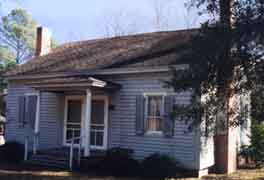 Traveling on, we
come to the McNeill Memorial Gardens and the restored home of John
Charles McNeill. Some years ago, the house was moved from its original
location near Wagram to the gardens, and its restoration begun. McNeill
was awarded the highest literary award in the state, the Patterson Cup,
in 1905. President Theodore Roosevelt made the presentation. In his
remarks, President Roosevelt said: Mr. McNeill’s poetry is an
achievement of which the Commonwealth of North Carolina and the South
have a right to be proud. Traveling on, we
come to the McNeill Memorial Gardens and the restored home of John
Charles McNeill. Some years ago, the house was moved from its original
location near Wagram to the gardens, and its restoration begun. McNeill
was awarded the highest literary award in the state, the Patterson Cup,
in 1905. President Theodore Roosevelt made the presentation. In his
remarks, President Roosevelt said: Mr. McNeill’s poetry is an
achievement of which the Commonwealth of North Carolina and the South
have a right to be proud.
In the
McNeill Memorial Gardens also stands the restored home of one of the
first temperance societies in America, the Richmond Temperance and
Literary Society. The society was organized in 1853 and this home built
shortly thereafter of red brick, which were molded by hand and burned in
homemade kilns. In the center of the ceiling was painted a group of gold
stars, one for each member. If a member died, his star was painted over
with silver. If a member broke his pledge and drank, the star was
painted black. Some stars were said to have several coats of black and
gold paint, for only when one reformed was his star painted gold again.
Here the members met regularly to read poetry and other literature and
to debate the issues of the day. At the apex of the roof a tall upturned
goblet, pointing its base to the sky, stood on a large open wooden book.
The goblet represented the temperance idea and the book represented the
literary idea. Sherman’s army, moving north during the closing days of
the Civil War, shot off the goblet and the book, but they have since
been restored. The Temperance Hall is registered as a national history
place by the Department of the Interior.
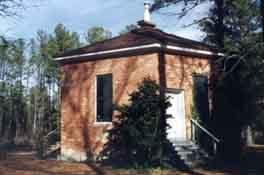 John Charles
McNeill was buried in Spring Hill Cemetery, which is adjacent to the
McNeill Memorial Gardens, the Temperance Hall, and his restored home. On
the monument is engraved one of his most quoted poems, Sundown: John Charles
McNeill was buried in Spring Hill Cemetery, which is adjacent to the
McNeill Memorial Gardens, the Temperance Hall, and his restored home. On
the monument is engraved one of his most quoted poems, Sundown:
Hills, wrapped in gray, standing along the west;
Clouds, dimly lighted, gathering slowly;
The star of peace at watch above the crest -
Oh holy, holy, holy.
We know so little what is best;
Wingless, we move so lowly;
But in thy calm all-knowledge let us rest -
Oh holy, holy, holy.
We
continue to one of the most historic spots in the county, Laurel Hill
Presbyterian Church, known locally as Old Laurel Hill. One of the
earliest communities in the county developed here. The church, which was
to be the mother church for most of the other Presbyterian churches in
the area, was established in 1797. This was a thriving business
community in the Post-Revolutionary War Period. Mr. Duncan McFarland
operated a tavern and stagecoach stop for the convenience of passengers
on the New York-New Orleans stage. He owned much land and is said to
have laid out a sizable town, which he hoped would grow to rival New
York, New Orleans, and Paris in time. It was here that the Scottish Fair
was held for years after its beginning in 1783. The fair was the
highlight of the year for many of the local settlers and for those who
came from some distance to spend the week or so camping nearby. As time
went on, the fair became so boisterous that some citizens began to
complain, and in 1873 a bill was passed in the state legislature to
abolish the fair. Old Laurel Hill declined as the business center of the
county after the railroad came through, laying its tracks to the south.
Old Laurel Hill was on the route of Sherman’s army when it passed
through in 1865, and the church yard was used as a camping place.
Legend
has it that the soldiers used some of the benches from the church to
build a bridge over the nearby creek and some of the soldiers carved
names and initials in the bell tower.
Cool
Springs Methodist Church and Silver Hill Presbyterian Church, two of the
oldest black churches in the county, both grew out of Old Laurel Hill
Presbyterian Church. Both of these are landmarks in this part of the
county.
The route
of the stagecoach line which ran through what is now Scotland County has
been marked as a Boy Scout project. The route ran from Gilchrist Bridge,
near present-day Wagram, by way of Old Laurel Hill, to a point on the
South Carolina line near Gibson. An 1839 post office map shows the route
and has marked in the area which is not Scotland County, only Montpelier
(across the Lumber River), Laurel Hill (now Old Laurel Hill),
Stewartsville and Barnes Bridge. Of course, no Laurinburg, Gibson,
Wagram, or present-day Laurel Hill were marked, because they did not
exist at that time.
Our next
stop is at Richmond Mill dam. During the years of the Civil War, this
was the site of a thriving gun factory operated by Mr. Murdock Morrison.
Of course, it was destroyed by Sherman’s men when they marched through
in 1865. Mr. Morrison married the granddaughter of Mr. James Buchanan
who had begun the manufacture of a well-known rifle in the years before
the war. Several of these Buchanan rifles are still in the possession of
county residents. Richmond Mill was also the site of the county’s first
textile plant, built by Colonel Charles Malloy in 1869. The machinery
was said to have been of English origin and came out of the hold of a
wrecked blockade runner off the cost near Wilmington. It was turned over
to Colonel Malloy as payment for grading work done by him when the
railroad went through. Colonel Malloy hired as superintendent Mr. Mark
Morgan, a Cumberland County man with a good deal of textile experience,
and Mr. Morgan became a partner in this first county textile plant. Thus
began Morgan Mills, a business which was to influence this county for
more than a century.
We move
on to Laurel Hill, a community which grew up around the railroad depot.
When the route of the railroad missed Old Laurel Hill, that community
declined as the business center of the area and much of the economic
activity moved to Laurel Hill depot. Records indicate there were about a
dozen families living there in 1861. The first industries were the
turpentine distilleries which existed prior to the war and for some
years afterward. Another early industry was tub-making. The tubs were
made of local juniper and the industry flourished for a number of years.
In the 1870s a mercantile business was being operated by Mr. John F.
McNair, who had started his business at Springfield. Later, the McNair
interests moved to Laurinburg and Mr. Z. V. Pate operated the business
in Laurel Hill. That business has been an important influence in the
community since that time. A post office was established in 1875. Laurel
Hill is the largest unincorporated community in Scotland County.
Near
Laurel Hill is Old Hundred. This small settlement marks the end of a
78-mile stretch of straight track beginning near Wilmington. This is
reportedly one of the longest stretches of straight track in the world.
We travel
on to Gibson. No community could be better named than this one for,
according to some local jokesters, there is a Gibson per square inch in
Gibson. The town was incorporated in 1899, but its history is much
older. It seems to have started when a widow, Mrs. Ziba Gibson, and her
two sons came to the area in the late 1700s. Mrs. Gibson’s grandson,
Noah, is believed to be the Gibson for whom the town is named. He built
and operated a store on the present town site. His brother, Thomas, a
Methodist minister, organized a church in the community, and in 1835, it
was moved to the site of the present-day St. John’s Church. Records show
there was a school as early as 1858. During the latter part of the
nineteenth century, Gibson was a thriving, prosperous town with stores,
businesses, and even a newspaper. Mr. Frank B. Gibson, of Gibson, was
chairman of the first board of county commissioners for Scotland County.
The
nearby Quaker settlement of Rockdale influenced the history of the area
greatly. The existence of the community is substantiated by deeds in the
possession of local residents. Some of the deeds mention the name of the
village and name streets in it. It is difficult, however, to picture the
thriving village with its grist mill, cotton gin, blacksmith shop, and
general store when one looks now at the deserted fields that were once
Rockdale. The Quakers came from Pennsylvania by way of Guilford County
and apparently planned their town in their characteristic neat manner
and laid off streets around a village square. The village was located
just south of Springfield, near Mason’s Cross. Mary Marine, mother of
Indiana’s famous poet James Whitcomb Riley, was born at Rockdale. Her
family and most of the other Quakers left for Indiana when slavery
became prevalent. They greatly opposed slavery and would not live where
their neighbors were slave holders. However, some of the Quakers
remained in this area because they had married into local families and
many of their descendants still live in the county.
Not far
from Rockdale is the retirement home of one of the county’s most
distinguished citizens, Bishop Walter Peele. Dr. Peele, a native of the
county, had a long and distinguished career as a Methodist minister. He
became a bishop of the Methodist Church and, upon retirement, returned
to Scotland County to live his last years in a home on X-Way Road. His
is buried in a family cemetery nearby.
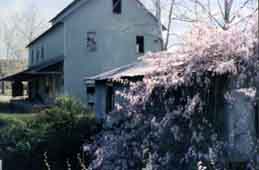 Mr. James Lytch,
inventor of a cotton planter which was patented in 1878, lived and had
his workshop at nearby X-Way. Mr. Lytch designed and made a number of
other implements used in farming throughout the South. Another inventor
and manufacturer of farm implements, Mr. John Blue, lived and worked in
the same area. His house has been restored and is used by the Scotland
County Parks and Recreation Commission. This is the site for the annual
John Blue Festival. Mr. James Lytch,
inventor of a cotton planter which was patented in 1878, lived and had
his workshop at nearby X-Way. Mr. Lytch designed and made a number of
other implements used in farming throughout the South. Another inventor
and manufacturer of farm implements, Mr. John Blue, lived and worked in
the same area. His house has been restored and is used by the Scotland
County Parks and Recreation Commission. This is the site for the annual
John Blue Festival.
We thus
end our imaginary tour of Scotland County. The history of Scotland
County is not the longest in the state, nor can we claim that it is
filled with glorious deeds. Our history, however, is and has been a
source of pride for most of our citizens. Those who can look back on
long family histories in this county have joined with the many who have
come from other areas to highlight and preserve that which was good in
the past, and to establish a firm foundation for a future in which we
can all take pride.
More facts about St.
Andrews
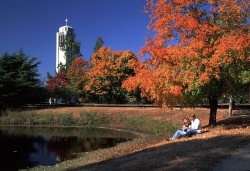 In September
1961, the first freshman class entered
St. Andrews Presbyterian
College. The campus, built on 800 acres just south of Laurinburg,
boasted a contemporary architectural design. With the 70-acre lake as
the focal point of the campus, the residence halls, athletic facilities,
library and academic buildings included Celtic crosses as a unique
design element. Ramps and electric doors were installed in the
buildings, making St. Andrews one of the first colleges in the country
to enable students with mobility difficulties to flourish at college.
An innovative and bold academic venture to an interdisciplinary
curriculum, a highly acclaimed college press, an award-winning pipe
band, national champion equestrian teams, and first-rate scholarship
have marked the distinctive character of St. Andrews. Bringing more
than 10,000 students from around the country and world to Laurinburg,
the College has played a vital role in the life of the county since its
opening. In September
1961, the first freshman class entered
St. Andrews Presbyterian
College. The campus, built on 800 acres just south of Laurinburg,
boasted a contemporary architectural design. With the 70-acre lake as
the focal point of the campus, the residence halls, athletic facilities,
library and academic buildings included Celtic crosses as a unique
design element. Ramps and electric doors were installed in the
buildings, making St. Andrews one of the first colleges in the country
to enable students with mobility difficulties to flourish at college.
An innovative and bold academic venture to an interdisciplinary
curriculum, a highly acclaimed college press, an award-winning pipe
band, national champion equestrian teams, and first-rate scholarship
have marked the distinctive character of St. Andrews. Bringing more
than 10,000 students from around the country and world to Laurinburg,
the College has played a vital role in the life of the county since its
opening.
|

